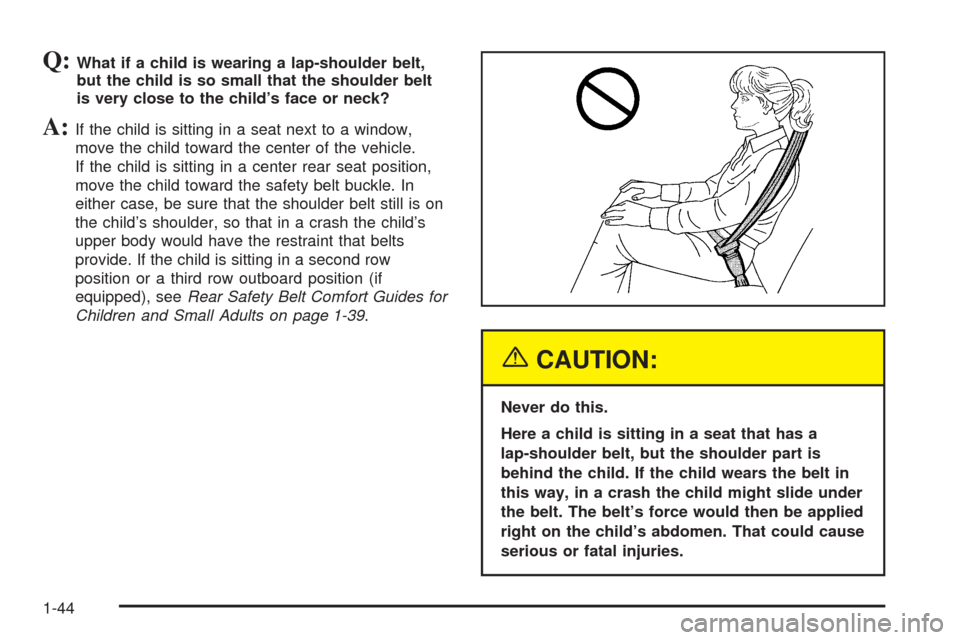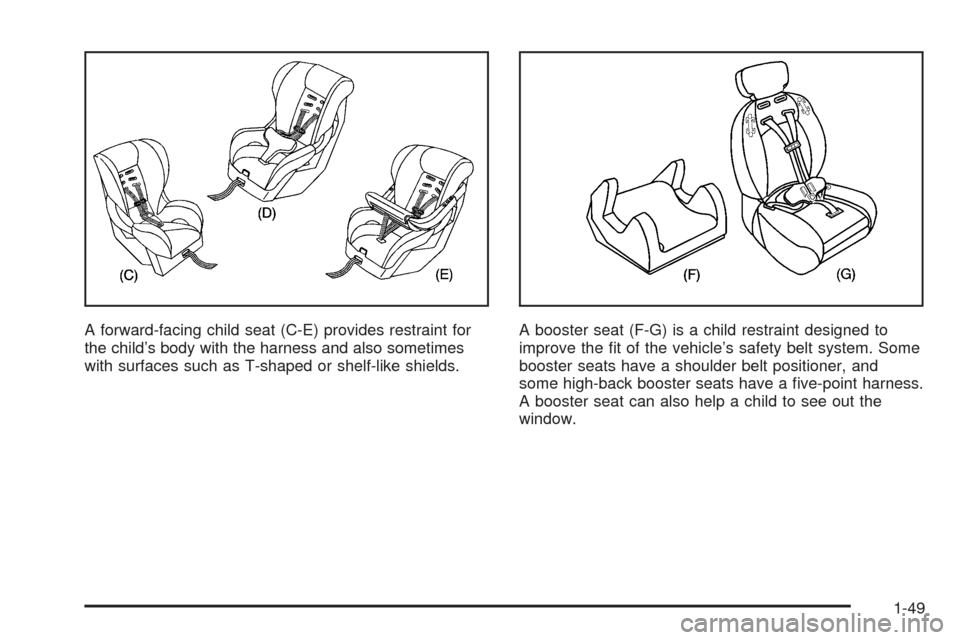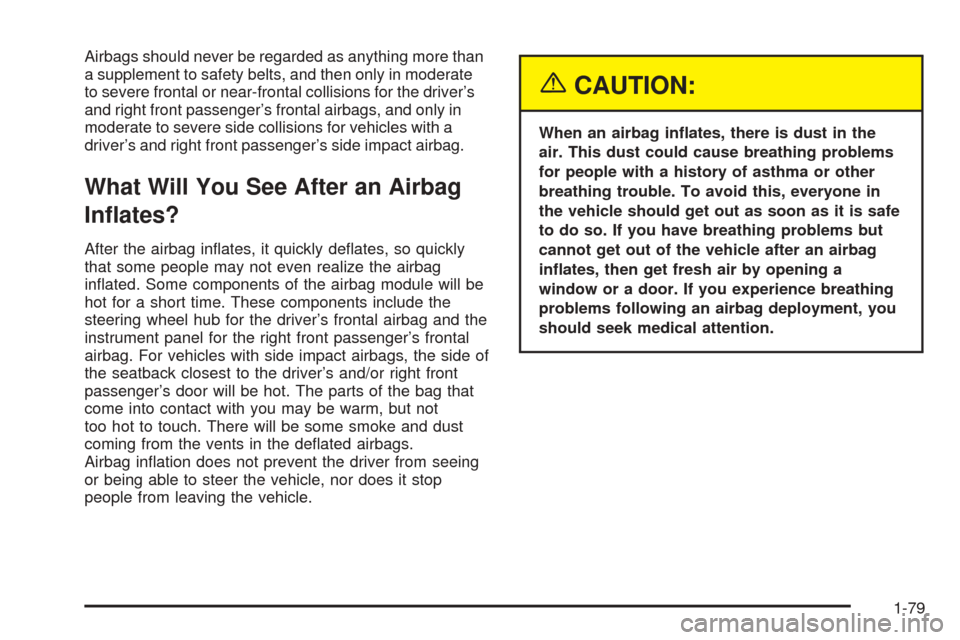2005 CHEVROLET UPLANDER window
[x] Cancel search: windowPage 1 of 460

Seats and Restraint Systems........................... 1-1
Front Seats
............................................... 1-3
Rear Seats
............................................... 1-7
Safety Belts
.............................................1-22
Child Restraints
.......................................1-42
Airbag System
.........................................1-72
Restraint System Check
............................1-87
Features and Controls..................................... 2-1
Keys
........................................................ 2-3
Doors and Locks
......................................2-11
Windows
.................................................2-24
Theft-Deterrent Systems
............................2-27
Starting and Operating Your Vehicle
...........2-31
Mirrors
....................................................2-43
OnStar
®System
......................................2-44
HomeLink®Wireless Control System
...........2-46
Storage Areas
.........................................2-51
Instrument Panel............................................. 3-1
Instrument Panel Overview
.......................... 3-4
Climate Controls
......................................3-25
Warning Lights, Gages, and Indicators
........3-31
Driver Information Center (DIC)
..................3-45
Audio System(s)
.......................................3-76Driving Your Vehicle....................................... 4-1
Your Driving, the Road, and Your Vehicle
..... 4-2
Towing
...................................................4-39
Service and Appearance Care.......................... 5-1
Service
..................................................... 5-3
Fuel
......................................................... 5-5
Checking Things Under the Hood
...............5-10
All-Wheel Drive
........................................5-44
Bulb Replacement
....................................5-46
Windshield Wiper Blade Replacement
.........5-50
Tires
......................................................5-51
Appearance Care
.....................................5-85
Vehicle Identi�cation
.................................5-94
Electrical System
......................................5-95
Capacities and Speci�cations
...................5-101
Maintenance Schedule..................................... 6-1
Maintenance Schedule
................................ 6-2
Customer Assistance and Information.............. 7-1
Customer Assistance and Information
........... 7-2
Reporting Safety Defects
...........................7-10
Index................................................................ 1
2005 Chevrolet Uplander Owner ManualM
Page 50 of 460

Q:What if a child is wearing a lap-shoulder belt,
but the child is so small that the shoulder belt
is very close to the child’s face or neck?
A:If the child is sitting in a seat next to a window,
move the child toward the center of the vehicle.
If the child is sitting in a center rear seat position,
move the child toward the safety belt buckle. In
either case, be sure that the shoulder belt still is on
the child’s shoulder, so that in a crash the child’s
upper body would have the restraint that belts
provide. If the child is sitting in a second row
position or a third row outboard position (if
equipped), seeRear Safety Belt Comfort Guides for
Children and Small Adults on page 1-39.
{CAUTION:
Never do this.
Here a child is sitting in a seat that has a
lap-shoulder belt, but the shoulder part is
behind the child. If the child wears the belt in
this way, in a crash the child might slide under
the belt. The belt’s force would then be applied
right on the child’s abdomen. That could cause
serious or fatal injuries.
1-44
Page 55 of 460

A forward-facing child seat (C-E) provides restraint for
the child’s body with the harness and also sometimes
with surfaces such as T-shaped or shelf-like shields.A booster seat (F-G) is a child restraint designed to
improve the �t of the vehicle’s safety belt system. Some
booster seats have a shoulder belt positioner, and
some high-back booster seats have a �ve-point harness.
A booster seat can also help a child to see out the
window.
1-49
Page 85 of 460

Airbags should never be regarded as anything more than
a supplement to safety belts, and then only in moderate
to severe frontal or near-frontal collisions for the driver’s
and right front passenger’s frontal airbags, and only in
moderate to severe side collisions for vehicles with a
driver’s and right front passenger’s side impact airbag.
What Will You See After an Airbag
In�ates?
After the airbag in�ates, it quickly de�ates, so quickly
that some people may not even realize the airbag
in�ated. Some components of the airbag module will be
hot for a short time. These components include the
steering wheel hub for the driver’s frontal airbag and the
instrument panel for the right front passenger’s frontal
airbag. For vehicles with side impact airbags, the side of
the seatback closest to the driver’s and/or right front
passenger’s door will be hot. The parts of the bag that
come into contact with you may be warm, but not
too hot to touch. There will be some smoke and dust
coming from the vents in the de�ated airbags.
Airbag in�ation does not prevent the driver from seeing
or being able to steer the vehicle, nor does it stop
people from leaving the vehicle.
{CAUTION:
When an airbag in�ates, there is dust in the
air. This dust could cause breathing problems
for people with a history of asthma or other
breathing trouble. To avoid this, everyone in
the vehicle should get out as soon as it is safe
to do so. If you have breathing problems but
cannot get out of the vehicle after an airbag
in�ates, then get fresh air by opening a
window or a door. If you experience breathing
problems following an airbag deployment, you
should seek medical attention.
1-79
Page 95 of 460

Keys...............................................................2-3
Remote Keyless Entry System.........................2-4
Remote Keyless Entry System Operation...........2-5
Doors and Locks............................................2-11
Door Locks..................................................2-11
Power Door Locks........................................2-12
Delayed Locking...........................................2-13
Automatic Door Locks...................................2-13
Programmable Automatic Door Unlock.............2-14
Lockout Protection........................................2-14
Dual Sliding Doors........................................2-14
Power Sliding Door (PSD)..............................2-17
Liftgate........................................................2-23
Windows........................................................2-24
Power Windows............................................2-25
Manual Rear Quarter Windows.......................2-26
Power Rear Quarter Windows........................2-26
Sun Visors...................................................2-27
Theft-Deterrent Systems..................................2-27
Content Theft-Deterrent.................................2-27
PASS-Key
®III ..............................................2-29
PASS-Key®III Operation...............................2-30Starting and Operating Your Vehicle................2-31
New Vehicle Break-In....................................2-31
Ignition Positions..........................................2-32
Retained Accessory Power (RAP)...................2-32
Starting the Engine.......................................2-33
Engine Coolant Heater..................................2-34
Automatic Transaxle Operation.......................2-35
All-Wheel Drive............................................2-38
Parking Brake..............................................2-38
Shifting Into Park (P).....................................2-39
Shifting Out of Park (P).................................2-40
Parking Over Things That Burn.......................2-41
Engine Exhaust............................................2-41
Running the Engine While Parked...................2-42
Mirrors...........................................................2-43
Manual Rearview Mirror.................................2-43
Outside Power Mirrors...................................2-43
Outside Convex Mirror...................................2-44
Outside Heated Mirrors..................................2-44
OnStar
®System.............................................2-44
Section 2 Features and Controls
2-1
Page 97 of 460

Keys
{CAUTION:
Leaving children in a vehicle with the ignition
key is dangerous for many reasons. They
could operate the power windows or other
controls or even make the vehicle move. The
children or others could be badly injured or
even killed. Do not leave the keys in a vehicle
with children.
This vehicle has a double sided key for the ignition and
the driver’s door lock.
2-3
Page 103 of 460

Remote Vehicle Start
This feature allows you to start the engine from outside
the vehicle. It may also turn the rear window defogger
if the outside temperature is below 45°F (7°C).
Laws in some local communities may restrict the use of
remote starters. For example, some laws may require
a person using remote start to have the vehicle in view
when doing so. Check local regulations for any
requirements on remote starting of vehicles.
/(Remote Vehicle Start):If your vehicle has the
remote vehicle start feature, the remote keyless entry
transmitter will have a button with this symbol on it.
An increased range of operation is provided with the
remote keyless entry transmitter that has the remote
vehicle start button.
Do not use the remote start feature if your vehicle is low
on fuel. Your vehicle may run out of fuel.To start the engine using the remote start feature, do the
following:
1. Aim the remote keyless entry transmitter, equipped
with the remote vehicle start button, at the vehicle.
2. Press and release the transmitter’s lock button, then
immediately press and hold the remote vehicle start
button until the vehicle’s turn signal lamps �ash,
or for at least two seconds, if the vehicle’s lights are
not visible. The vehicle’s doors will be locked.
3. When the vehicle’s engine starts, the parking lamps
will turn on and remain on while the engine is
running.
After a remote start, the engine will automatically shut
off after 10 minutes unless a time extension has
been done or the vehicle’s key is inserted into the
ignition switch and turned to RUN.
The maximum number of remote starts or remote start
attempts between ignition cycles with the key is two.
2-9
Page 117 of 460

If the door does not travel to the fully open position,
press the overhead console switch to the override
(deactivation) position and slide the door fully open and
closed. Check for foreign objects in the tracks. Repeat
the procedure starting with Step 1. If the door resists
travel to the fully open position, see your dealer
for service.
Liftgate
To unlock or lock the liftgate from the outside, use the
remote keyless entry transmitter. For more information,
seeRemote Keyless Entry System Operation on
page 2-5. You can also use the power door lock switch
to lock and unlock the liftgate.
Open the liftgate using the handle located above the
license plate. Once slightly opened, the liftgate will rise
by itself. Lamps in the rear of the vehicle will come
on, illuminating the rear cargo area.
Notice:If you open the liftgate without checking for
overhead obstructions such as a garage door,
you could break the liftgate glass. Always check to
make sure the area above the liftgate is clear
before opening it.
{CAUTION:
It can be dangerous to drive with the liftgate
open because carbon monoxide (CO) gas can
come into your vehicle. You cannot see or
smell CO. It can cause unconsciousness and
even death. If you must drive with the liftgate
open or if electrical wiring or other cable
connections must pass through the seal
between the body and the liftgate:
Make sure all other windows are shut.
Turn the fan on your heating or cooling
system to its highest speed and select the
control setting that will force outside air
into your vehicle. SeeClimate Control
System on page 3-25.
If you have air outlets on or under the
instrument panel, open them all the way.
SeeEngine Exhaust on page 2-41.
2-23